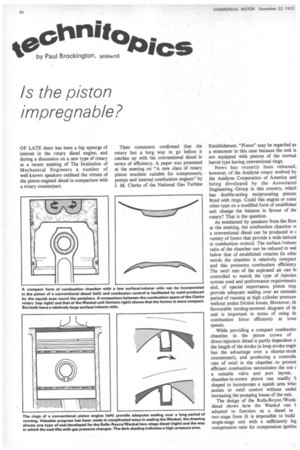Is the piston impregnable?
Page 32

Page 33

If you've noticed an error in this article please click here to report it so we can fix it.
OF LATE there has been a big upsurge of interest in the rotary diesel engine, and during a discussion on a new type of rotary at a recent meeting of The Institution of Mechanical Engineers a number of well-known speakers outlined the virtues of the piston-engined diesel in comparison with a rotary counterpart. Their comments confirmed that the rotary has a long way to go before it catches up with the conventional diesel in terms of efficiency. A paper was presented at the meeting on "A new class of rotary piston machine suitable for compressors, pumps and internal combustion engines" by J. M. Clarke of the National Gas Turbine Establishment. "Piston" may be regarded as a misnomer in this case because the unit is not equipped with pistons of the normal barrel type having conventional rings.
News has recently been released, however, of the Anidyne rotary evolved by the Anidyne Corporation of America and being developed by the Associated Engineering Group in this country, which has double-acting reciprocating pistons fitted with rings. Could this engine or some other type on a modified form of established unit change the balance in favour of the rotary? That is the question.
As mentioned by speakers' from the flooi at the meeting, the combustion chamber oi a conventional diesel can be produced in variety of forms that provide a wide latitude in combustion control. The surface /volumi ratio of the chamber can be reduced to wel below that of established rotaries (in othe words the chamber is relatively compact and this promotes combustion efficiency The swirl rate of the aspirated air can 131 controlled to match the type of injectioi system used and performance requirements and, of special importance, piston ring provide adequate sealing over an extendei period of running at high cylinder pressure without undue friction losses. Moreover, th favourable turning-moment diagram of th unit is important in terms of using th combustion force efficiently at lowe speeds.
While providing a compact combustio chamber in the piston crown of direct-injection diesel is partly dependent o the length of the stroke (a long-stroke engin has the advantage over a shorter-strok counterpart), and producing a controlle rate of swirl in the chamber...to promot efficient combustion necessitates the use c a suitable valve and port layout, chamber-in-crown piston can readily b shaped to incorporate a squish area whic assists in swirl control without undul increasing the pumping losses of the unit.
The design of the Rolls-Royce /Wank diesel shows how the Wankel can t adapted to function as a diesel in two-stage form (it is impossible to build singlet stage unit with a sufficiently hig compression ratio for compression ignitio nit neither the R-R Wankel nor the Clarke mgine can be produced with a combustion :hamber having the compactness of the 'worst" conventional diesel, although the :llarke unit could be produced as a Mgle-stage type.
Decisive factor The rotary could offer a higher iower-to-weight ratio (at a substantially ncreased fuel consumption) and flame emperatures are lower, which is favourable o controlling oxides of nitrogen without a :atalyst. This could be a decisive factor in ts adoption for a wide range of ,pplications.
While a typical rotary engine has a good nechanical efficiency, its lubrication system ; of the constant-loss type and employing a iigh detergency oil is correspondingly xpensive. During the IMechE meeting a umber of the Esso research staff said that e would rather sell a small quantity of ood oil to users of piston engines than a trger quantity of a lower-grade oil to the perators of rotary engines.
The most frequently cited advantage of le established types of rotary over the iston engine is that the principle of peration enables heavy reciprocating omponents to be eliminated. But is that the dvantage it is claimed to be?
When a piston is at or about top dead entre and the engine is running at higher mn, a large proportion of the combustion )rce is absorbed in reversing the piston and effect is restored to the cycle lower in the ,roke when the connecting rod/crank angle as increased. As the combustion pressure reduced with downward movement of the iston the torque on the crank is increased n. a given combustion pressure. And this Ives a more favourable turning moment lagram.
leducing seal leakage Full details of the Anidyne rotary have to be released, but the fact that it has mventional types of piston augers well for ; sealing properties. The big problem of ■ tary engine designers is to reduce leakage :ross the seal at lower speeds. Mr Clarke imitted at the meeting that sealing oblems of his new rotary had not been /ercome.
An Anidyne engine has Yet to be .oduced in either petrol or diesel form. The tor in which the pistons reciprocate is rcular and good sealing of the rotor as ;:11 as the pistons should be possible. It ,ould also be feasible to incorporate, in e power pistons, a combustion chamber of itable shape for the diesel cycle to provide squish area. So it could be a world beater. The unit incorporates a charging cylinder id there is promise that it could be veloped to operate at high boost pressures
low rpm. It could probably be built at low cost but it would not have a weight or ace advantage, according to its critics. Perhaps the last word should come )m Mr N. Vulliamy of Perkins, who inted out at the meeting that the piston gine was simple and cheap to make and at when a rotary had been fitted with its ciliary gear it was a shapeless mess!












































































